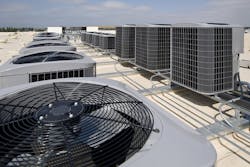Energy efficiency standards issued on Friday are expected to save an estimated $50 billion in energy costs. The 1.7 trillion kilowatt hours that are projected to be saved over 30 years of sales amount to almost as much energy as that created by all the coal burned in the U.S. to generate electricity in a year.
The change represents the largest energy and pollution savings of any rule ever issued by the U.S. Department of Energy. They apply to rooftop air conditioners, which cool about half the commercial floor space in the nation, as well as commercial warm air furnaces, which are typically installed with the rooftop commercial air conditioners.
"These new standards will bring down the cost of doing business and improve bottom lines by letting companies invest money they used to spend on heating and cooling," said Steve Nadel, executive director of ACEEE. "This will in turn stimulate the economy, create jobs and bring us closer to the finish line of the president’s climate goals for appliance standards.”
Based on DOE’s estimates, the new rooftop air conditioner standards will save more energy and cut more emissions than any other standards completed by the agency, outpacing the previous record-setters that covered electric motors (2014) and fluorescent tube lamps (2009).
Rooftop air conditioners are typically found on low-rise buildings such as big box stores, schools, apartment buildings, restaurants, and offices. The new standards would net a typical building owner between $4,200 and $10,100 over the life of a single rooftop air conditioner. Unlike a typical household that has just one central air conditioning unit, commercial spaces have multiple units and according will see more savings. A typical big box store, for example, often has over 20 units.
“As in Paris, when the community of nations made history by banding together to fight climate change, these historic efficiency standards were the result of an accord reached by stakeholders who set aside their competing interests for the common good,” said NRDC President Rhea Suh. “These are very, very promising days in the global fight to slow, stop, and reverse climate change, the central environmental challenge of our time.”
The organizations participating in negotiations that led to the announcement are: Air-Conditioning, Heating, and Refrigeration Institute (AHRI), the Appliance Standards Awareness Project (ASAP), the American Council for an Energy-Efficient Economy (ACEEE), and Natural Resources Defense Council (NRDC). Thirteen other stakeholders including representatives of individual manufacturers, installers, utilities, environmental groups and efficiency organizations also participated.
The rooftop air conditioner standards will take effect in two phases, increasing minimum efficiency by about 10 percent as of Jan. 1, 2018, and by 25-30 percent as of Jan. 1, 2023. Standards for new warm air furnaces that are typically installed as a unit with a commercial air conditioner also become effective in 2023.
